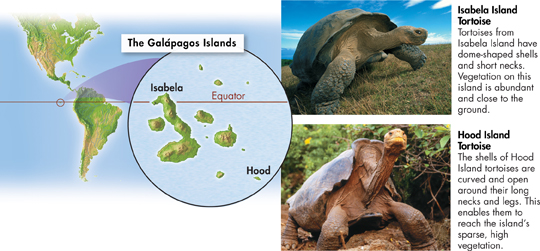
FIGURE 16–2 Tortoise Diversity Among tortoises in the Galápagos Islands, shell shape corresponds to different habitats. Isabela Island has high peaks, is rainy, and has abundant vegetation. Hood Island, in contrast, is flat, dry, and has sparse vegetation.
ddSpecies Vary Locally There were other puzzles, too. For example, Darwin found two species of rheas living in South America. One lived in Argentina's grasslands and the other in the colder, harsher grass and scrubland to the south.  Darwin noticed that different, yet related, animal species often occupied different habitats within a local area.
Darwin noticed that different, yet related, animal species often occupied different habitats within a local area.
Other examples of local variation came from the Galápagos Islands, about 1000 km off the Pacific coast of South America. These islands are close to one another, yet they have different ecological conditions. Several islands were home to distinct forms of giant land tortoises. Darwin saw differences among the tortoises but didn't think much about them. In fact, like other travelers, Darwin ate several tortoises and tossed their remains overboard without studying them closely! Then Darwin learned from the islands' governor that the tortoises' shells varied in predictable ways from one island to another, as shown in Figure 16–2. Someone who knew the animals well could identify which island an individual tortoise came from, just by looking at its shell.
Darwin also observed that different islands had different varieties of mockingbirds, all which resembled mockingbirds that Darwin had seen in South America. Darwin also noticed several types of small brown birds on the islands with beaks of different shapes. He thought that some were wrens, some were warblers, and some were blackbirds. He didn't consider these smaller birds to be unusual or important—at first.
Species Vary Over Time In addition to collecting specimens of living species, Darwin also collected fossils, which scientists already knew to be the preserved remains or traces of ancient organisms. Some fossils didn't look anything like living organisms, but others did.
MYSTERY CLUE

Like the small brown birds on the Galápagos, Hawaiian honeycreepers live on islands with slightly different habitats. How might these varied habitats have affected the evolution of honeycreeper species?
Table of Contents
- Formulas and Equations
- Applying Formulas and Equations
- Mean, Median, and Mode
- Estimation
- Using Measurements in Calculations
- Effects of Measurement Errors
- Accuracy
- Precision
- Comparing Accuracy and Precision
- Significant Figures
- Calculating With Significant Figures
- Scientific Notation
- Calculating With Scientific Notation
- Dimensional Analysis
- Applying Dimensional Analysis




